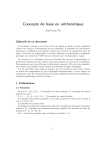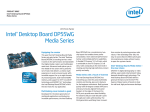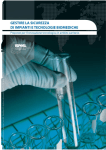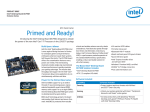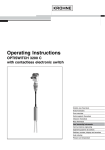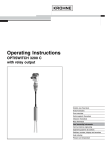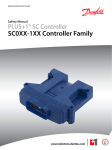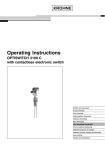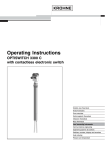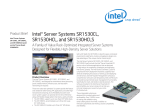Download Operating Instructions - VEGATOR 111, 112
Transcript
Safety Manual VEGATOR 111, 112 With SIL qualification Document ID: 49220 Contents Contents 1 Document language 2Scope 2.1 Instrument version............................................................................................................. 4 2.2 Area of application............................................................................................................ 4 2.3 SIL conformity................................................................................................................... 4 3Planning 3.1 Safety function.................................................................................................................. 5 3.2 Safe state.......................................................................................................................... 5 3.3 Prerequisites for operation................................................................................................ 5 4 Safety-related characteristics 4.1 Characteristics in accordance with IEC 61508 for level detection...................................... 6 4.2 Characteristics in accordance with IEC 61508 for range monitoring.................................. 6 4.3 Figures according to ISO 13849-1..................................................................................... 7 4.4 Supplementary information............................................................................................... 8 5Setup 5.1 General information........................................................................................................... 9 5.2 Adjustment instructions..................................................................................................... 9 6 Diagnostics and service 6.1 Behaviour in case of failure............................................................................................. 10 6.2Repair............................................................................................................................. 10 7 Proof test 7.1 General information......................................................................................................... 11 7.2 Test 1 - without input current simulation........................................................................... 11 7.3 Test 2 - with input current simulation................................................................................ 11 7.4 Test 3 - with switch-on pulse checking............................................................................. 12 8 Appendix A - Test report 9 Appendix B - Term definitions 10 Supplement C - SIL conformity 2 VEGATOR 111, 112 • With SIL qualification 49220-EN-141002 Editing status: 2014-09-26 1 Document language 1 Document language Das vorliegende Safety Manual für Funktionale Sicherheit ist verfügbar in den Sprachen Deutsch, Englisch, Französisch und Russisch. EN The current Safety Manual for Functional Safety is available in German, English, French and Russian language. FR Le présent Safety Manual de sécurité fonctionnelle est disponible dans les langues suivantes: allemand, anglais, français et russe. RU Данное руководство по функциональной безопасности Safety Manual имеется на немецком, английском, французском и русском языках. 49220-EN-141002 DE VEGATOR 111, 112 • With SIL qualification 3 2 Scope 2Scope 2.1 Instrument version This safety manual applies to signal conditioning instruments VEGATOR 111, 112 Input signal: • NAMUR (IEC 60947-5-6) • from HW Ver 1.0.0 • • Version VEGATOR 111: fail safe relay Version VEGATOR 112: two-point control mode Valid version: The following functions are excluded from safety-relevant applications: 2.2 Area of application The signal conditioning instruments can be used with a suitable transducer for level detection or range monitoring in a safety-instrumented system in accordance with IEC 61508 in the low demand mode or high demand mode: • • Up to SIL2 in a single-channel architecture Up to SIL3 in a multiple-channel architecture • • Version VEGATOR 111: relay 1 Version VEGATOR 121: relay 1 or relay 2 The following interface should be used to output the measured value: In a SIL3 architecture the two channels may not be used redundantly in the VEGATOR 112! 2.3 SIL conformity The SIL conformity was independently judged and certified by the TÜV Rheinland according to IEC 61508:2010 (Ed.2).1) The certificate is valid for the entire service life of all instruments that were sold before the certificate expired! 4 Verification documents see appendix VEGATOR 111, 112 • With SIL qualification 49220-EN-141002 1) 3 Planning 3Planning Level detection with VEGATOR 111 or 112 3.1 Safety function The transducer fed by the signal conditioning instrument generates a signal of > 1.6 mA or < 1.6 mA corresponding to the process variable. A level detection relay is switched dependent on this signal and on the selected mode. This applies for both channels in the VEGATOR 112 version if the twopoint control is not selected. Mode monitoring with VEGATOR 112 Two transducers fed by the signal conditioning instrument each generates a signal of > 1.6 mA or < 1.6 mA corresponding to the process variable. Two limit values can therefore be measured for range monitoring. The following points must be observed here: • • • • Safe state The two NO contacts must be connected in series Channel for the upper limit: Max. mode Channel for the lower limit: Min. mode The two-point control may not be selected 3.2 Safe state The safe condition of the output is independent of the mode, by definition the currentless state of the relay (quiescent current principle). Therefore only the NO contact may be used for safety-relevant applications. Output signals in case of malfunction Instructions and restrictions Relay outputs: • 3.3 Prerequisites for operation • The measuring system should suit the application. The application• • • • • 49220-EN-141002 NO contacts open specific limits must be maintained The specifications according to the operating instructions manual, particularly the current load on the output circuits, must be kept within the specified limits To avoid a fusing of the relay contacts, these must be protected by an external fuse that triggers at 60 % of the max.contact current load. The installation site must comply with IP 54 protection The instructions in chapter "Safety-related characteristics", paragraph "Supplementary information" must be noted All parts of the measuring chain must correspond to the planned "Safety Integrity Level (SIL)" VEGATOR 111, 112 • With SIL qualification 5 4 Safety-related characteristics 4 Safety-related characteristics VEGATOR 111 or one channel of the VEGATOR 112 4.1 Characteristics in accordance with IEC 61508 for level detection Parameter Value Safety Integrity Level SIL2 in single-channel architecture Hardware error tolerance HFT = 0 Instrument type Type A Mode Low demand mode, High demand mode SIL3 in multiple channel architecture2) SFF MTBF > 60 % 1.93 x 106 h (220 years) 3) Fault reaction time < 2 s 4) Failure rates λS 170 FIT λDD 29 FIT λDU 46 FIT λH 0 FIT λL 0 FIT λAD 0 FIT PFDAVG 0.038 x 10-2 (T1 = 1 year) PFDAVG 0.057 x 10-2 (T1 = 2 years) PFDAVG 0.111 x 10-2 (T1 = 5 years) PFH 0.046 x 10-6 1/h λAU 19 FIT Coverage with the proof test (PTC) Remaining dangerous undetected failures PTC Test 1 5 FIT 89 % Test 2 and 3 2 FIT 96 % Test type5) VEGATOR 112 4.2 Characteristics in accordance with IEC 61508 for range monitoring Parameter Value Safety Integrity Level SIL2 in single-channel architecture SIL3 in multiple channel architecture6) 3) 6 VEGATOR 111, 112 • With SIL qualification 49220-EN-141002 Homogeneous redundancy possible (see note in the section "Area of Applicaton"). Including errors outside the safety function. 4) Time between the occurrence of the event and the output of a fault signal. 5) See section "Proof test". 6) Homogeneous redundancy possible. 2) 4 Safety-related characteristics Parameter Value Hardware error tolerance HFT = 0 Instrument type Type A Mode Low demand mode, High demand mode SFF > 60 % MTBF7) 1.65 x 106 h (188 years) Fault reaction time8) < 2 s Failure rates λS 240 FIT λDD 44 FIT λDU 74 FIT λH 0 FIT λL 0 FIT λAD 0 FIT PFDAVG 0.062 x 10-2 (T1 = 1 year) 0.091 x 10-2 (T1 = 2 years) PFDAVG 0.178 x 10 (T1 = 5 years) PFDAVG PFH -2 λAU 35 FIT 0.074 x 10-6 1/h Coverage with the proof test (PTC) Remaining dangerous undetected failures PTC Test 1 8 FIT 89 % Test 2 and 3 2 FIT 97 % Test type9) 4.3 Figures according to ISO 13849-1 Level detection with VEGATOR 111 or one channel of the VEGATOR 112 49220-EN-141002 Range monitoring with VEGATOR 112 Derived from the safety-related characteristics, the following figures result according to ISO 13849-1 (machine safety):10) Parameter Value MTTFd 1522 years DC 38 % Performance Level 4.61 x 10-8 1/h (corresponds to "e") Parameter Value MTTFd 970 years DC 37 % Performance Level 7.38 x 10-8 1/h (corresponds to "e") Including errors outside the safety function. Time between the occurrence of the event and the output of a fault signal. See section "Proof test". 10) ISO 13849-1 was not part of the certification of the instrument. 7) 8) 9) VEGATOR 111, 112 • With SIL qualification 7 4 Safety-related characteristics Determination of the failure rates 4.4 Supplementary information The failure rates of the instrument were determined by an FMEDA according to IEC 61508. Basis for the calculations are the component failure rates according to SN 29500. All figures refer to an average ambient temperature of 40 °C (104 °F) during the operating time. For higher temperatures, the values should be corrected: • • Assumptions of the FMEDA Similar factors apply if frequent temperature fluctations are expected. • The failure rates are constant. Take note of the useful service life of • • • • • Calculation of PFDAVG the components according to IEC 61508-2. Multiple errors are not taken into account Wear on mechanical parts is not taken into account Failure rates of external power supplies are not taken into account The environmental conditions correspond to an average industrial environment To avoid a fusing of the relay contacts, these must be protected by an external fuse The values for PFDAVG specified above were calculated as follows for a 1oo1 architecture: (1 – PTC) × λ DU × LT PTC × λ DU × T1 PFDAVG = + λ DD x MTTR + 2 2 • • • • Multiple channel architecture Continuous application temperature > 50 °C (122 °F) by factor 1.3 Continuous application temperature > 60 °C (140 °F) by factor 2.5 T1 (Proof Test Interval) MTTR = 8 h PTC = 90 % LT = 10 years In multiple channel systems for SIL3 applications, this measuring system can also be used in a homogeneously redundant configuration. The safety-related characteristics must be calculated especially for the selected structure of the measuring chain using the stated failure rates. In doing this, a suitable Common Cause Factor must be considered (see IEC 61508-6, appendix D). 49220-EN-141002 8 VEGATOR 111, 112 • With SIL qualification 5 Setup 5Setup 5.1 General information Mounting and installation Take note of the mounting and installation instructions in the operating instructions manual. Adjustment elements 5.2 Adjustment instructions The operating elements must be set according to the application. The function of the operating elements as well as the parameter adjustment procedure are described in the operating instructions. The safety function must be considered unsafe during the setting process! Other actions must be taken to maintain the safety function if necessary. With regard to the switch on/swich off delay it must be ensured that the sum of all switching delays from the transducer to the actuator is adapted to the process safety time! 49220-EN-141002 The instrument must be protected against inadvertent or unauthorized operation! VEGATOR 111, 112 • With SIL qualification 9 6 Diagnostics and service 6 Diagnostics and service 6.1 Behaviour in case of failure Internal diagnosis The instrument is permanently monitored by an internal diagnostic system. If a malfunction is detected, the respective output signals change to the status configured especially for this condition (see section "Safe status"). Error messages The occurrence of an error is signalled by the red LED and, if necessary, by the fail safe relay. Reaction when malfunctions occur 6.2Repair If faults are detected, the entire measuring system must be shut down and the process held in a safe state by other measures. The manufacturer must be informed of the occurrence of a dangerous, undetected error (incl. fault description). 49220-EN-141002 10 VEGATOR 111, 112 • With SIL qualification 7 Proof test 7 Proof test Objective 7.1 General information To identify possible undetected, dangerous failures, the safety function must be checked by a proof test at adequate intervals. It is the user's responsibility to choose the type of testing. The time intervals are subject to the PFDAVG in chapter "Safety-related characteristics"). For documentation of these tests, the test protocol in the appendix can be used. If one of the tests proves negative, the entire measuring system must be switched out of service and the process held in a safe state by means of other measures. Preparation Unsafe device status In a multiple channel architecture this applies separately to each channel. • • Determine safety function (mode, switching points) If necessary, remove the instruments from the safety chain and maintain the safety function by other means Warning: During the function test, the safety function must be treated as unreliable. Take into account that the function test influences downstream connected devices. If necessary, you must take other measures to maintain the safety function. After the function test, the status specified for the safety function must be restored. Conditions Procedure Expected result Coverage of the test Conditions 49220-EN-141002 Procedure Expected result 7.2 Test 1 - without input current simulation • • Use of any transducer Output signals correspond to the current limit level 1. Push the min./max. switch on the VEGATOR 111, 112 2. Check relay contacts • • about 1: Relay and LED display change states about 2: Relay contacts open and close according to item 1 See Safety-related characteristics 7.3 Test 2 - with input current simulation • • Possibility of sensor current simulation exists Output signals correspond to the current limit level 1. Invert sensor current by means of the min./max. switch on the transducer (2.1 mA/1.2 mA) 2. Check relay contacts • • about 1: State of relay and LED display follow the simulated sensor current about 2: Relay contacts open and close according to item 1 VEGATOR 111, 112 • With SIL qualification 11 7 Proof test Coverage of the test Conditions Procedure Expected result See Safety-related characteristics 7.4 Test 3 - with switch-on pulse checking • • 1. Press test key 2. Check relay contacts • • Coverage of the test Use of a VEGAVIB 60 or VEGAWAVE 60 transducer with NAMUR output Output signals correspond to the current limit level about 1: State of relay and LED display follows the switch-on pulse (the curve of the switch-on pulse is described in the transducer operating instructions) about 2: Relay contacts open and close according to item 1 See Safety-related characteristics 49220-EN-141002 12 VEGATOR 111, 112 • With SIL qualification 8 Appendix A - Test report 8 Appendix A - Test report Identification Company/Tester Plant/Instrument TAG Meas. loop TAG Instrument type/Order code Instrument serial number Date, setup Date, last function test Test reason Test scope (…) (…) without input current simulation (…) with switch-on pulse checking (…) Setup Proof test (…) Mode Delay times Max. Channel 1 (…); channel 2 (…) Min. (…) with input current simulation (…) Channel 1 (…); channel 2 (…) (…) Range monitoring Switch-on delay Switch-off delay Test result for test 1 and 2 Limit level signal Channel 1 Min./Max. switch channel 1 Condition Relay 1 Limit level signal Condition Test result Channel 2 Min./Max. switch channel 2 Limit level signal State function test Condition Test result Relay 2 Test result for test 3 Limit level signal Channel 1 State function test Condition Relay 1 Channel 2 Empty signal Empty signal Full signal Full signal Relay 2 49220-EN-141002 Confirmation Date: Signature: VEGATOR 111, 112 • With SIL qualification 13 9 Appendix B - Term definitions Abbreviations 9 Appendix B - Term definitions SIL Safety Integrity Level HFT Hardware Fault Tolerance SFF Safe Failure Fraction PFDAVG Average Probability of dangerous Failure on Demand PFH Average frequency of a dangerous failure per hour (Ed.2) FMEDA Failure Mode, Effects and Diagnostics Analysis FIT Failure In Time (1 FIT = 1 failure/109 h) λSD Rate for safe detected failure λS λS = λSD + λSU λDU Rate for dangerous undetected failure λL Rate for failure, who causes a low output current (≤ 3.6 mA) λAU Rate for diagnostic failure (undetected) λSU Rate for safe undetected failure λDD Rate for dangerous detected failure λH Rate for failure, who causes a high output current (> 21 mA) λAD Rate for diagnostic failure (detected) DC Diagnostic Coverage PTC Proof Test Coverage T1 Proof Test Interval LT Useful Life Time MTBF Mean Time Between Failure MTTF Mean Time To Failure MTTR Mean Time To Restoration (Ed.2) MTTFd Mean Time To dangerous Failure (ISO 13849-1) PL Performance Level (ISO 13849-1) 49220-EN-141002 14 VEGATOR 111, 112 • With SIL qualification 10 Supplement C - SIL conformity 49220-EN-141002 10 Supplement C - SIL conformity VEGATOR 111, 112 • With SIL qualification 15 All statements concerning scope of delivery, application, practical use and operating conditions of the sensors and processing systems correspond to the information available at the time of printing. Subject to change without prior notice © VEGA Grieshaber KG, Schiltach/Germany 2014 VEGA Grieshaber KG Am Hohenstein 113 77761 Schiltach Germany Phone +49 7836 50-0 Fax +49 7836 50-201 E-mail: [email protected] www.vega.com 49220-EN-141002 Printing date:

















